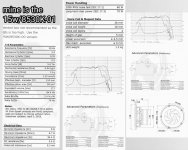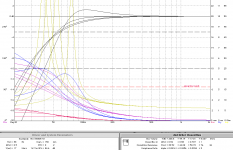Where is the T/S data? Link?
Without the Q those numbers are just broad brushstrokes and tell you little.
dave
Without the Q those numbers are just broad brushstrokes and tell you little.
dave
"Back of a napkin" type calc's from the published spec's:
At 0.25 ft³, the Qtc would be in the low 0.9's, signaling a modest peak in response
At 0.75 ft³, the Qtc would be in the high 0.6's, indicating pretty flat response
The smaller box will have a bit of rise in the 70Hz region, sounds like what you're looking for. I wouldn't be averse to going a touch smaller, but I'm not a good rule follower.
I wouldn't port it, especially up that high. And remember, I'm not a good rule follower.
At 0.25 ft³, the Qtc would be in the low 0.9's, signaling a modest peak in response
At 0.75 ft³, the Qtc would be in the high 0.6's, indicating pretty flat response
The smaller box will have a bit of rise in the 70Hz region, sounds like what you're looking for. I wouldn't be averse to going a touch smaller, but I'm not a good rule follower.
I wouldn't port it, especially up that high. And remember, I'm not a good rule follower.
A little less guess. Normally one would aim for a butterworth (Q=0.707) roll-off which indicates an undamped box of 17 litres, 14-15 in practise with damping. XO would be at about 54Hz. The 2nd[/sub] order roll-off can be used as is or half of a linkwitz riley tth[/sub] order.

Or put it in a smaller box and do a linkwitz riley transform to flatten and control the rolloff.
dave
Or put it in a smaller box and do a linkwitz riley transform to flatten and control the rolloff.
dave
Attachments
Thanks everyone, your help is very much appreciated. Incidentally, there's a fairly impressive thunderstorm going on, which reminds me nature's subwoofer is much much bigger!
I love the thunder claps that rip for five seconds or more, before the BOOOM!!!
I love the thunder claps that rip for five seconds or more, before the BOOOM!!!
Fs, Vas, Qt play the dominant roles.
dave
Yes these are the "MAIN" 3 TSP's. Keep in mind that the DCR of an inductor or any other resistance will INCREASE the Qt. You can actually use this to your advantage if you have a really low Q driver.
Have you read Vance Dickason Loudspeaker Design Cookbook? I recommend it as the overall best one to start with. The science and math and theory are all there; if you had high school algebra, trig. and geometry, it is a breeze; not overly complicated; easy to follow and understand.
I do use online calculators these days. Some of them give you options so you can calculate an "ideal" box and then try different sizes from there. Different box shapes are also important; the above book explains some of these things as well.
I've seen ads for this book many times, but am guilty of using online calculators like Strassacker, or others.
As for cabinet shapes, unless it's a backhorn or transmission line, I prefer a golden ratio cuboid, or sometimes a tapered to the back cabinet.
Thanks for the intel.
As for cabinet shapes, unless it's a backhorn or transmission line, I prefer a golden ratio cuboid, or sometimes a tapered to the back cabinet.
Thanks for the intel.
- Home
- Loudspeakers
- Multi-Way
- Loudspeaker Cabinet Volume question.

